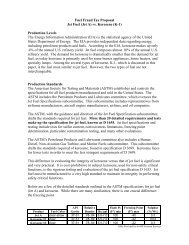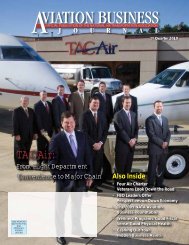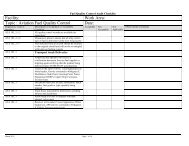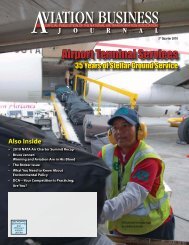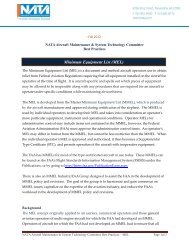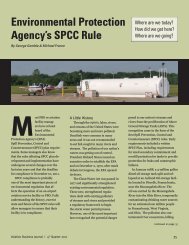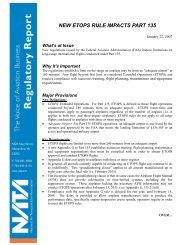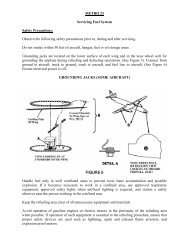Bridgeford Flying Services: A Vintage Napa Valley FBO You ... - NATA
Bridgeford Flying Services: A Vintage Napa Valley FBO You ... - NATA
Bridgeford Flying Services: A Vintage Napa Valley FBO You ... - NATA
You also want an ePaper? Increase the reach of your titles
YUMPU automatically turns print PDFs into web optimized ePapers that Google loves.
<strong>You</strong>’ve Been Served!<br />
Continued from page 21<br />
court must defer to the FAA’s determination<br />
that the information<br />
sought by the subpoena is relevant<br />
unless the determination is “obviously<br />
wrong.” In this context, it<br />
should come as a profound relief<br />
that, unlike every other government<br />
agency, the FAA is never<br />
“obviously wrong” about anything,<br />
right?<br />
Deposition Testimony<br />
A deposition involves questioning<br />
in which a witness testifies<br />
under oath, and everything he or<br />
she says is transcribed by a court<br />
reporter. A subpoena in a civil<br />
case to an organization like a corporation<br />
may be accompanied by<br />
a notice advising the organization<br />
of its duty to designate someone<br />
to testify for it at a deposition<br />
about specific topics. Because an<br />
organization cannot physically<br />
testify, it will be obliged to provide<br />
a spokesperson who can. Failure<br />
to designate a spokesperson may<br />
cause the organization to be punished<br />
for contempt of court. If you<br />
receive such a request, you should<br />
consult with your lawyer about<br />
who the lucky testifying “designee”<br />
will be.<br />
A deposition is serious business.<br />
<strong>You</strong> must budget sufficient<br />
time to prepare and then prepare<br />
some more. Planning to appear at<br />
a deposition and bark, “I object!”<br />
in response to every question<br />
may sound like a good idea now,<br />
but wait until you have to explain<br />
yourself to a judge. A complete<br />
discussion of depositions is<br />
beyond the scope of this article.<br />
However, always bear in mind<br />
that, like your mother always told<br />
you, honesty is the only policy<br />
when testifying under oath.<br />
Gathering<br />
Responsive Documents<br />
Before you ever receive a subpoena,<br />
it is generally a good<br />
practice to designate a person<br />
with responsibility for managing<br />
your documents and records and<br />
coordinating responses to requests<br />
for information. Establishing a<br />
specific document management<br />
protocol will, as a general matter,<br />
help your business run smoothly<br />
and give you a head start when<br />
and if you receive a subpoena for<br />
documents.<br />
The following are things to<br />
consider when you receive a subpoena<br />
for documents:<br />
Identify each specific entity<br />
from which the subpoena<br />
seeks information. The subpoena<br />
may be directed at some members<br />
of your corporate family and<br />
not others. <strong>You</strong> want to make sure<br />
that the correct entity responds.<br />
Determine the location and<br />
format of responsive information<br />
and who may keep<br />
it. Responsive documents can<br />
be kept both as hard copies and<br />
as electronic data. Responsive<br />
information can be anywhere: at<br />
the bottom of an old filing cabinet<br />
in a warehouse, on a hard drive in<br />
a computer that used to belong to<br />
a manager but now resides in the<br />
maintenance shop, etc. If a company<br />
does not have a systematic<br />
procedure for storing, indexing,<br />
and retrieving documents, finding<br />
what you need can present a<br />
challenge. Early on in the process,<br />
it is important to clearly define,<br />
in specific terms, the universe of<br />
places where responsive information<br />
may be kept.<br />
Establish which person<br />
at the company is going to<br />
direct document gathering.<br />
Ideally, this would be the person<br />
your company already charges<br />
with responsibility for managing<br />
documents. A point person who<br />
can deal directly with staff at all<br />
levels in the company as well as<br />
with outside counsel is an asset<br />
that will drive the process forward<br />
as efficiently as possible.<br />
Determine the extent to<br />
which the company requires<br />
the assistance of outside<br />
counsel. {For purposes of full<br />
disclosure, in my experience as an<br />
attorney...} It usually is best for<br />
outside counsel to become involved<br />
in the document-gathering<br />
process at the earliest possible<br />
stage. Clients typically “forget”<br />
about the existence of places<br />
where potentially responsive<br />
documents may be kept. In addition<br />
to offering legal advice about<br />
substantive issues, a lawyer experienced<br />
in document production<br />
can ask specific, often annoyingly<br />
persistent questions to ensure that<br />
your search is complete.<br />
Issue a hold on the destruction<br />
of documents as appropriate.<br />
<strong>You</strong> do not want to be<br />
accused of purposely or inadvertently<br />
destroying evidence. Make<br />
a plan in consultation with your<br />
attorney to find and preserve every<br />
conceivable responsive document,<br />
including electronically<br />
stored data. The need to preserve<br />
must be communicated to people<br />
at all levels and all locations of the<br />
organization who are likely to possess<br />
relevant material.<br />
Carefully consider all<br />
potential privileges against<br />
disclosure that may apply.<br />
Communications with attorneys<br />
obviously fall within this category,<br />
but do not forget that you may<br />
have confidential or proprietary<br />
data as well as personnel records<br />
subject to various disclosure rules.<br />
Determine the most sensible<br />
way to capture responsive<br />
documents and data. Options<br />
include copying documents yourself,<br />
calling in a vendor to make<br />
copies, and scanning all hard copies<br />
to create an image database.<br />
This latter approach is often more<br />
cost effective than old-fashioned<br />
photocopying because once a document<br />
is imaged, it can be printed<br />
Continued on page 24<br />
22 Aviation Business Journal | 2 nd Quarter 2008



